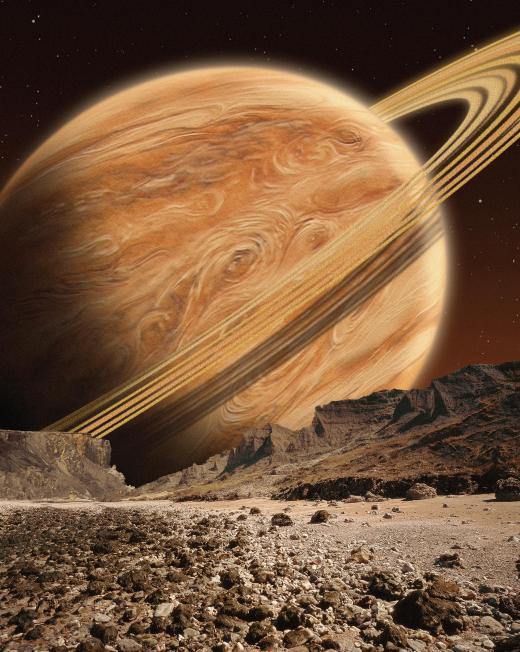What is the Huygens Probe?
 Michael Anissimov
Michael Anissimov
The Huygens probe is a component of the Cassini-Huygens unmanned mission to Saturn. Named after the Dutch astronomer, mathematician, and physicist Christiaan Huygens, the Huygens probe's main claim to fame is that it is the first man-made object to land on the surface of a celestial body in the outer solar system. On 14 January 2005, Huygens descended into the atmosphere of Titan, a moon of Saturn, and took various readings. It gave humanity its first look at the surface of Titan, long obscured by a thick methane atmosphere.
The Cassini-Huygens program is an joint effort between NASA and the European and Italian Space Agencies. The total cost of the program is about $3.26 billion USD, with money continuing to be spent as scientists analyze the data relayed from the Cassini orbiter, which continues to circle Saturn.

The Huygens probe is about 1.3 meters (4.2 ft) across, packed with various scientific instrumentation including cameras, a wind sensor, radiometer, spectrometer, and more. As Titan's surface contains multiple huge hydrocarbon oceans, the prospect that it might have landed in liquid was taken into account, although it ended up touching down on land. It slowly descended into the atmosphere over the course of two and a half hours, and continued to transmit data from the surface for 90 minutes thereafter, at which point the Cassini orbiter became too distant to transmit data to.
The long time of the descent was attributable to Titan's dense atmosphere: in fact, Titan's atmosphere is so dense and gravity so low that you could fly there by flapping artificial wings, like the mythical Icarus.

The Huygens mission was almost a failure. One of the two radio channels used to transmit information, Channel A, failed due to an operational commanding error. As a result, only 350 pictures of Titan's surface were relayed to Cassini, rather than the planned 700. Because Huygens had too little energy to transmit data directly to Earth, it transmitted to Cassini first, which then forwarded the data to our space agencies.
Possibly the greatest triumph of the Huygens probe was the confirmation of the existence of massive hydrocarbon lakes on the surface. Various marine geographical features were observed, such as islands and drainage channels.
AS FEATURED ON:
AS FEATURED ON:













Discussion Comments
Cassini is the other unmanned NASA spacecraft that has a mission to Saturn. In fact, it's called the Cassini-Huygens mission because the Cassini spacecraft and the Huygens probe work together to better understand Saturn and its moons.
Saturn actually has a lot of moons. I did not know this until recently either. Titan is its biggest moon, at least of the ones that have been discovered so far. A lot of the moons are said to be covered by a sheet of ice. They are difficult to see because of Saturn's rings but scientists, along with better technology and telescopes are getting better at this. So new moons are discovered all the time.
I actually think that Enceladus is the most exciting Saturn moon and not Titan. Enceladus has water, scientists have findings that point towards an underground ocean. That's very exciting because as everyone knows, where there is water, there is life.
@ysmina-- I won't pretend that I know much about these things because I don't. But I did see some pictures of the surface of Titan taken by the Huygens probe. The photos actually were not very clear. A lot of the good images out there are artists' recreation of Huygens probe on Titan and what Titan looks like.
Of course, at the time, this was a good accomplishment. But now, I think they can do much better. Moreover, there were things that went wrong with the Huygens probe which shouldn't have happened. It was a first step though, and that's why it's important.
Has anyone seen pictures of the Huygens probe on Titan? I saw pictures of it in science class and they were very cool. The probe is actually small, but it was able to take nice pictures of the surface of Titan. In the pictures, there was soil and lots of rocks. It actually looked similar to something we could see on earth.
Post your comments